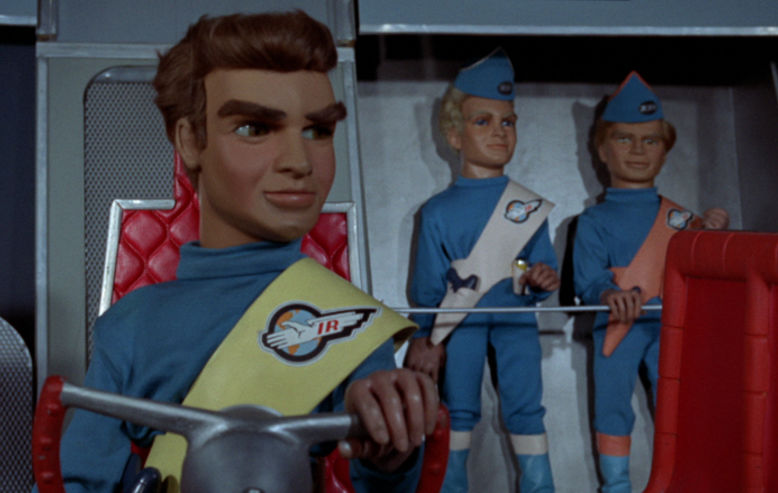Starting in the early 1960s, Gerry and Sylvia Anderson made an indelible impact on the world of television with their groundbreaking production technique known as “Supermarionation”. Their most popular show, Thunderbirds, premiered in 1965 and created a global phenomenon that has spanned generations. With its Atomic Age aesthetics and innovative production techniques, Thunderbirds has made an enduring impact on pop culture, cherished by legions of fans and influencing science fiction and animation for decades. Whether Thunderbirds was a childhood favorite or you’re discovering the show for the first time, we’re celebrating the June 9th Blu-ray debut of the series with these fun facts.
“Supermarionation” combines marionette puppetry with scale model special effects shots.
The term itself is a portmanteau of "super," "marionette" and "animation,” and Gerry Anderson was said to have coined the term as an homage to Ray Harryhausen’s stop-motion animation technique “Dynamation.”
Trey Parker and Matt Stone’s 2004 satire Team America: World Police was also produced using Supermarionation puppets.
They coined the term “Supercrappymation” for their production, as the puppet strings were intentionally left visible and the limitations of supermarionation techniques were affectionately parodied.

Anderson was inspired to create the Thunderbirds' International Rescue after hearing about rescue crews during a mine disaster in 1963 West Germany.
In the early 1980s, Gerry Anderson was instrumental in helping to create a real charity, The International Rescue Corps, a UK-based urban search-and-rescue organization.
Despite the technological advances made by the puppeteering team at AP films throughout the early 1960s, it was difficult to have the marionettes walk convincingly.
Hence, many scenes in Thunderbirds have the characters sitting, standing, or take place in a vehicle. |
...... |  |
Depicting hands in action was also a challenge, as the production team was unable to create jointed hands for the puppets.
Instead, shots that required pushing buttons or turning a key used close up shots of a human actor’s hands.
The five Tracy sons were each named after an American astronaut from the Mercury Seven.
Scott (named after Scott Carpenter), Virgil (Virgil Grissom), John (John Glenn), Gordon (Gordon Cooper), and Alan (Alan Shepard).

Lady Penelope Creighton-Ward was modeled after Sylvia Anderson.
Anderson also provided her voice.

The series spawned two spinoff supermarionation movies (1966’s Thunderbirds Are Go and 1968’s Thunderbird 6) as well as a live-action, feature-length film adaptation, 2004’s Thunderbirds.
Despite its fervent fanbase, Thunderbirds has never had the same success at the box office as it has on television. While the first two films were well-reviewed, they underperformed at the box-office, and the live-action 2004 film was a critical and commercial flop. In 2015, a CGI-animated television series, Thunderbirds are Go! premiered in the UK in conjunction with the series' 50thanniversary.
 |
...... |  |
| ...... | ||
 |
 |
In addition to the feature films, Thunderbirds has also been adapted in a number of other mediums.
In 1990, eight episodes were adapted into radio dramas that aired on BBC Radio 5. In 1965, Lady Penelope and “Nosey” Parker were given their own comic strip, which was followed by a Thunderbirds comic strip in 1966.Three new audio-only episodes were released on EP between 1965 and 1967, and in the early 1990s Penguin Books released several volumes of Thunderbirds Audio Books on cassette.

In addition to the human characters, the five Thunderbird "crafts" piloted by the Tracy sons are characters in their own right.
Thunderbird 1 is a rocket-like plane, typically flown by Scott, used for quick response missions. Virgil flies Thunderbird 2, a large cargo plane. Thunderbird 3 is a space rocket piloted by Alan or John. Gordon navigates the submarine-esque Thunderbird 4, and last but not least, there’s Thunderbird 5, the space station.
 |
...... |  |
Thunderbirds brand merchandise has proven to be incredibly popular, spanning products from lunchboxes to playsets, action figures to video games.
Since 1965, more than 3,000 different Thunderbirds branded items have been sold.
 |
...... |  |
 |
 |
Despite not have a particularly large cast, only one episode of Thunderbirds (The Mighty Atom) actually features the entire regular cast and all five Thunderbird crafts.

The iconic opening credit sequence, which starts with the "5, 4, 3 2, 1: Thunderbirds Are Go!" narration, is often named one of the best title sequences in television history and is a quintessential example of 1960s British Spy Fiction.
“The Thunderbirds March” was written by Barry Gray, who served as musical director for all of the Anderson’s early shows.
The episode “Attack of the Alligators” was inspired by the H.G. Wells novel The Food of The Gods and Paul Leni's 1927 silent film The Cat And The Canary.
Baby crocodiles were used on the model set to give the illusion of giant alligators, and it was the first time that live animals were used in the filming of the Supermarionation productions.


